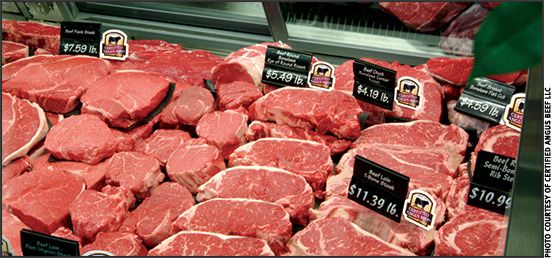
2017 Retail and Wholesale Beef Prices
Wholesale beef product markets continue to adjust following unusual price relationships from record-high prices in late 2014 through early 2016.
Prices for “all fresh retail beef” were $5.833 per pound (lb.) in July, up 1.0% year over year. This price category has increased each month this year since January.
July Choice beef prices were $6.10 per lb., down from the June level of $6.207 per lb., but fractionally higher than July 2016.
The all-fresh-retail-beef price increased relative to the broiler composite retail price in July. The current ratio of retail-beef-to-broiler prices is equal to the record level set in July 2015. The retail-beef-to-pork price ratio is also holding steady at levels near the record during the high prices of 2014 into 2016 and, like the beef-to-broiler retail price ratio, are at levels well above historical ratios prior to 2014.
Wholesale cutout values have dropped sharply in the past two months, with Choice cutout values down to a weekly average of $197.66 per hundredweight (cwt.) in mid-August after climbing to a stronger-than-expected seasonal peak of $250.86 per cwt. in mid-June. Choice beef prices have struggled to find a summer bottom, with ample supplies and summer heat weighing on beef markets. Weekly Choice cutout values averaged higher year over year from late April until last week.
Select cutout values also increased from January to a weekly seasonal peak of $224.54 per cwt. in mid-May before dropping to last week’s $194.81 per cwt. The Choice-Select spread has displayed an exaggerated seasonal pattern this year, increasing from a seasonal low of $1.25 per cwt. in mid-February to an impressive $30.38 per cwt. in the second week of June. This was the highest weekly Choice-Select spread since the bovine spongiform encephalopathy (BSE)-induced market turbulence in October 2003. The Choice-Select spread has decreased back to a narrow $2.25 per cwt. in mid-August.
The dramatic seasonal Choice-Select spread pattern seems to mostly be a reflection of dynamic Choice beef demand; unexpectedly strong in the spring and struggling recently. Wholesale beef product values indicate that middle meats have weakened the most recently with rib and loin values dropping relatively more compared to chuck and round values. Choice ribeye values increased to a pronounced seasonal peak in June, well above year-ago levels, but have dropped back to last year’s values recently. Choice tenderloin and strip loin wholesale values have been plus or minus year-ago levels all year but lower year over year recently. Chuck and round values have mostly been higher year over year in recent weeks.
The ground beef market has been quite volatile this year with 50% lean fed trimmings exhibiting an unusual and pronounced spike in May before returning to year-ago levels recently. Lean (90%) trimmings followed year earlier levels through late April before rising sharply higher year over year for the past several weeks.
Longer term, wholesale beef product markets continue to adjust following unusual price relationships that emerged during the record-high prices from late 2014 through early 2016. Many lower-value products increased relative to middle meats during this period but are returning to more typical price relationships in 2017. Products from the chuck, round and sirloin increased relative to loin and rib prices during this period. The Choice-Select spread narrowed during the record price period and, as noted above, has widened back out to near record levels at times in 2017. Looking back, the past five years provides a good case study to help understand the complexities of beef demand and substitution between beef products, as well as the interaction between beef and other meats in dynamic meat market conditions.

Editor’s Note: Derrell Peel is livestock marketing specialist for Oklahoma State University Extension. He wrote this article for the Aug. 21, 2017, edition of the Cow-Calf Corner newsletter. It is reprinted with permission.






